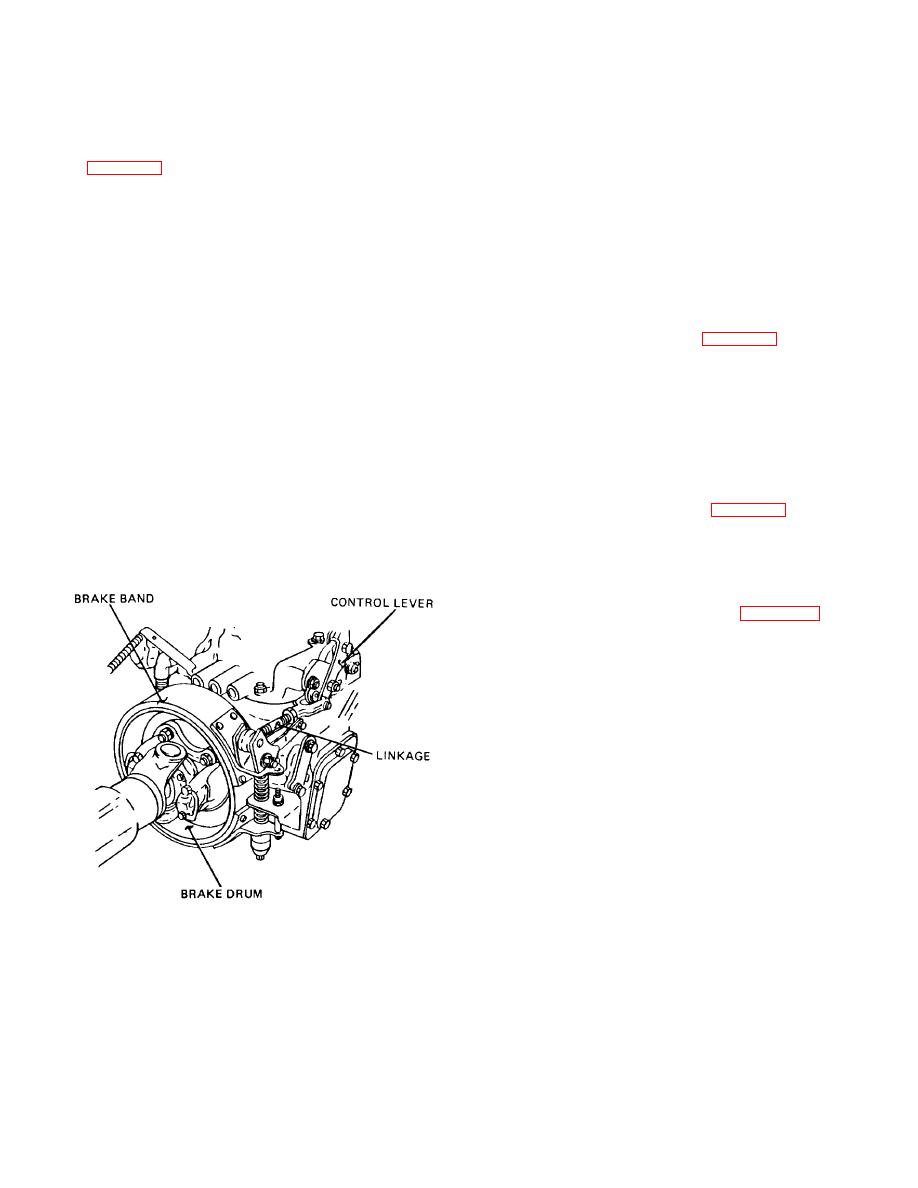
| Tweet |

Custom Search
|
|

|
||
 TM 9-8000
by means of a cam lever arrangement. A spring
Section IV. 34-17.ContractingTransmissionBrake.The
removes the shoes from the disk faces when the hand or
contracting transmission brake generally is mounted
foot lever is released.
between the output shaft of the transmission or transfer
case (fig. 34-15). The rotating drum is splined or bolted
34-19. Parking Brake. The parking brake usually is
to the transmission or transfer main shaft. The brake is
operated by an auxiliary foot pedal or hand lever located
designed for either forward or backward motion of the
in the driver compartment. This brake mechanism is
vehicle. For this reason, one end of the brake band is
designed to keep the vehicle stationary when the
anchored just opposite that at which the operating force
operator is not present. There are different systems used
is applied. As the brakes are applied, the halves of the
for the disk and drum brake assemblies; each is
brake band wrap against the drum, preventing rotation in
discussed below.
either direction. The mechanism for operating this brake
usually is a simple bellcrank arrangement connected to a
a. Disk Type. The disk brake system uses two basic
handbrake lever by a flexible cable. A spring disengages
types of parking brake systems (fig. 34-17). One system
the brake band lining when the actu- ating force is
incorporates an integral parking brake mechanism in the
released. The contracting transmission brake usually is
caliper assembly. This system uses an actuator screw,
not used in modern vehicles.
operated by a lever and the parking brake cable, to apply
the brake pads. As the parking brake is applied, the
34-18. Disk Transmission Brake.The disk transmission
actuator screw is rotated, which forces the piston
brake (fig.34-16)usually is mounted on the rear of the
assembly and inner brake pad outward to meet the rotor.
transmission or transfer case, or on a cross member of
Further application shifts the caliper assembly and
the frame. The rotating member of the brake consists of
applies the outer brake pad. Another parking brake
a specially designed steel disk splined or bolted to the
system used with disk brake systems uses two small
transmission output shaft. This disk has two faces that
internally expanding brakeshoes (fig. 34-17). The shoes
act as the rotating braking surface. Passages are
are expanded against the internal section of the brake
arranged so that a large volume of air cools the braking
disk by an actuating lever operated by the parking brake
surface when the disk is rotating. The shoes are
cable.
supported on swinging brackets and are clamped against
the
disk
faces
b. Drum Brake Type. The drum brake system uses
one basic parking brake assembly (fig. 34-17). This
configuration uses a parking brake lever that is activated
by a flexible cable routed to both rear wheels. As the
parking brake is applied, the parking brake lever pivots
on the top of the secondary brakeshoe. This action
allows the parking brake strut to move forward and apply
the primary shoe. Further application now pivots the
parking brake lever on the parking brake strut, thereby
forcing the secondary shoe against the brakedrum.
34-20. Advantages and Disadvantages of Trans-
mission Brakes. Transmission and transfer assembly
brakes theoretically are more efficient than wheel brakes
because the braking effort is multiplied by the final drive
ratio, and their braking action is equalized perfectly
through the differential. However, they put a severe
strain on the power transmission system, and they are
not
TA233867
Figure 34-15. Contracting Transmission Brake.
34-18
|
||
 |
||